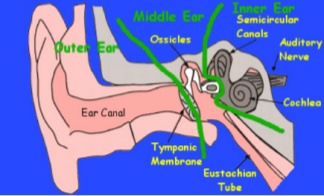- Types of Hearing Loss
- Causes of Hearing Loss
Newborn hearing screens provide reassurance that your child has normal hearing at birth, unfortunately children can develop hearing loss at any age. Pediatric hearing loss is categorized according to the part of a child’s auditory system that is affected. At ENT for Children our team of Pediatric ENT physicians and aduiologist will work with your child to determine whether they suffer from conductive, sensorineural or mixed hearing loss. To understand what type of hearing loss your child has, it helps to understand some about the anatomy of your child’s ear.
The ear is divided into 3 parts:
- Outer Ear – includes the ear canal and the ear we can see on the outside
- Middle Ear – the ear drum is the dividing point between the outer and middle ear. The middle ear contains the small bones (the ossicles) that connect the ear drum to the nerve
- Inner Ear – includes the cochlear (hearing) and vestibular system (balance)
Types of Hearing Loss

Sensorineural Hearing Loss
Sensorineural hearing loss is any process that affects the nerve portion of hearing. This includes the inner ear, the microscopic hair cells within the cochlea that turn the nerve on and off, the nerve that connects the inner ear to the brain and any part of the hearing pathways within the brain. Fortunately, in most children with sensorineural hearing loss the nerve still functions. It is typically damage to the microscopic hair cells within the inner ear that leads to the hearing loss. Depending upon your child’s level of hearing loss the team at ENT for Children’s may discuss hearing aids or cochlear implants as treatment options.
Conductive Hearing Loss
Conductive hearing loss is any process that prevents sound from moving appropriately through the outer or middle ear. For example, when a child has an ear infection fluid accumulates in the middle ear. This limits the movement of sound through the middle ear and creates a conductive hearing loss. This type of hearing loss goes away when the middle ear fluid resolves. Another example of conductive hearing loss is a child born without an ear canal (aural atresia). In this example sound cannot move through the ear canal, so even though the inner ear functions normally sound cannot move through the absent ear canal and the child has a conductive hearing loss. Treatment options for children with hearing loss vary depending on the cause of their conductive hearing loss.
Causes of Hearing Loss
Both conductive and Sensorineural hearing loss can be acquired or congenital.
Causes of Sensorineural Hearing Loss
Sensorineural hearing loss might be caused by the following:
- Genetics
- Premature birth
- Exposure to loud noises
- Meningitis
- Jaundice
- Certain intravenous antibiotics
- Viral infections
- Trauma to the ear
Causes of Conductive Hearing Loss
Conductive hearing loss might be caused by one or more of the following factors:

- Damage to the external ear canal
- Anomalies to the pinna (outside of the ear)
- Anomalies of the ossicles or the three bones that is responsible for delivering sound waves to the cochlea
- Excessive ear wax
- Foreign bodies in the ear
- Damage or problems to the Eustachian tube
- Eardrum perforation
- Otitis media (inflammation in the inner ear) and other ear infections
- Fluid in the middle ear
- Head injuries
- Absence of an outer, inner or middle ear
